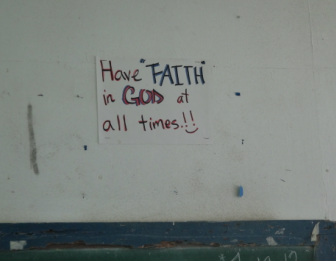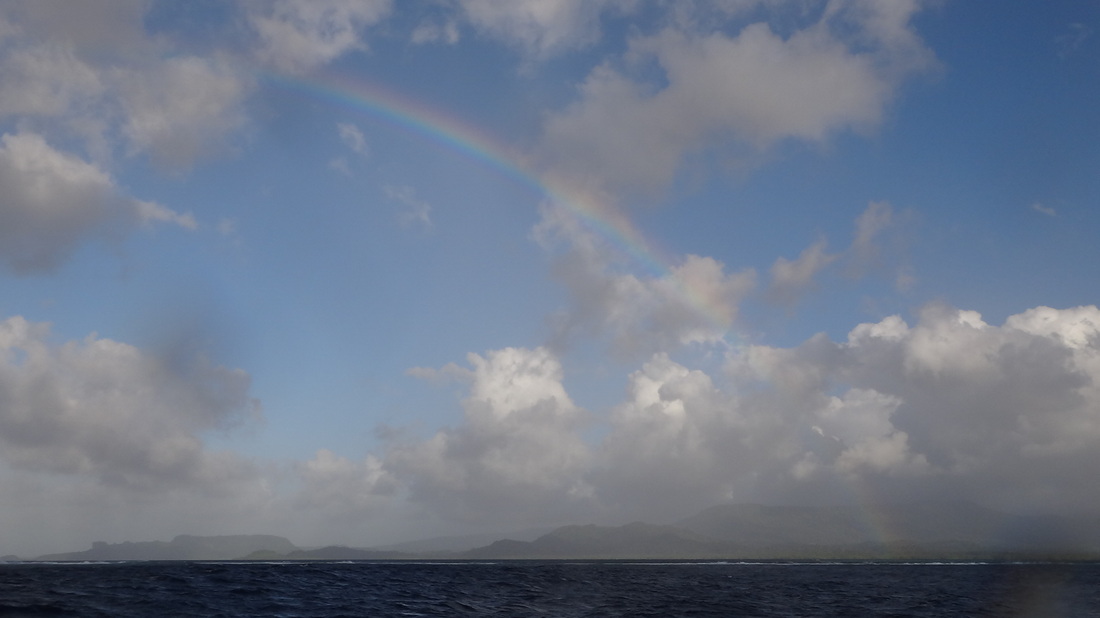
A sign in one of our adopted schools
One area that has always interested me is the intersection of faith and politics. It interests me so much in fact that I majored in Political Science and Religion. Ever since I declared in these two majors, I have always heard, “Well, that’s an interesting combination.” It’s a long story how I ended up studying these two topics which are touchy alone, but completely explosive when combined. Part of the story involves my affinity to debate. Those who know me know I love to debate (not to be confused with arguing) and I often said throughout college that I was studying the two topics that were the catalyst for the most “spirited conversation.” In retrospect however, I see my studying of politics and religion as a great decision, for two central reasons.
First of all, I learned how to think critically and write. I can’t imagine two skills more essential for success than these. Confronting conflicting theories and paradigms forced me to think for myself, draw my own conclusions and articulate my ideas. Secondly, what I have realized while here in Pohnpei about these two areas is by studying Political Science and Religion, I essentially majored in “Institutional Studies.” As I mentioned in my last post, studying political science involved learning about political institutions and the principles and conduct of government. What is more “institutionalized” in the truest sense of the word than government? There are clearly set rules and regulations with various laws and policies that dramatically impact the citizenry under control of that government. Religion also is encased in institutions, with various faith traditions producing their own rituals, governed by their doctrine, ultimately seeking to influence people’s lives. It’s important to note here that when I say “religion,” I’m referring to the institutionalized framework, such as the Church, rather than an individual’s personal faith journey.
Here’s what I find fascinating – government, in its most basic form, is seeking to organize and establish order in a chaotic world. It does this through creating laws and allotting power to groups and individuals to be held responsible for upholding stability. Religion on the other hand, sees a chaotic world and seeks to establish order through faith in things we cannot see, or rituals which will transcend the mundane of this world and create order in either this world or the next. While most Americans are familiar with the separation of church and state, it’s interesting to note that in a way, the “church and state” (read: religion and government) are seeking to address the same fundamental need.
Some of you are probably wondering, “What does this have to do with Pohnpei?” Well I have found here that there is no separation of church and state whatsoever. First, some background – almost the entire population is Christian and most are “active” in their faith by being involved in a church. Actions outside of Sunday morning for many though provoke questions of how genuine their faith is. I have seen mostly Protestant churches, though there are plenty of Catholic churches revealing the Spanish influence on Pohnpei. My experience so far has showed the churches here to be extremely institutionalized. It has been disheartening as a Christian to see churches feud over petty differences, demonizing their fellow brothers and sisters in Christ, while raising themselves up as “better” than those “other” people. My theory is that because there is such a small population to evangelize that churches become extra competitive, dividing for silly reasons and condemning all those who aren’t part of their church.
Despite the differences between the churches, there are signs of religion everywhere. Examples include Bible verses posted in government offices, prayers being recited before government meetings and everyone saying “Merry Christmas” in December rather than the politically correct “Happy Holidays.” I have also noticed religion’s influence in the schools. The most notable example is when we went to a school and the entire school was going to Catholic mass for the morning. Perhaps I should remind you that we work in public schools. That was a real eye-opener for me. I’ve also witnessed plenty of signs in the schools like the one above, signs you would expect to see in a Christian school.
Given the pervasive nature of religion in Pohnpeian culture, I have come to the conclusion that Pohnpeians are more inclined to look toward religious institutions rather than government institutions to create order. I believe this is the case for multiple reasons. First, the current government isn’t “theirs.” Yes the Federated States of Micronesia have an official Constitution and are a sovereign nation. Their National Constitution details how there are three branches of the government, executive, legislative and judicial, with checks and balances throughout. Each State has its own government while it is also part of the national government as well. Does this sound familiar? Without mixing words, the FSM essentially copied the United States Constitution. Hey, it’s not a bad template, but again, it’s not “theirs.” Something that is “theirs” is the traditional leadership, which still has an extremely large influence, arguably more so than the elected leaders. The Nanwharki (nan-war-kee), i.e. the Chief of each municipality, along with the other respected leaders, have considerable power and represent a critical part of Pohnpeian culture.
Christianity might not be “theirs” either – after all, the locals had their own religion(s) before the white man appeared. This is true, but missionaries arrived more than 30 years before Spain claimed Pohnpei as a colony in the 1880s and overall, Christianity has been adopted as part of Pohnpeian culture. As Pohnpei is a homogenous society I don’t see a particular problem with the amalgamation of religion and government. In America, the melting pot of the world, what I see every day with the influence of religion in government and daily life here in Pohnpei would not be tolerated. For now, witnessing this dynamic in Pohnpei is yet another cultural experience for me.
I know I mentioned at the end of my last post I would discuss the largest obstacle to education reform in Pohnpei. I decided though it’s nice to mix up my posts rather than just post every week about education. So I’m going to hold you in suspense for another week.
First of all, I learned how to think critically and write. I can’t imagine two skills more essential for success than these. Confronting conflicting theories and paradigms forced me to think for myself, draw my own conclusions and articulate my ideas. Secondly, what I have realized while here in Pohnpei about these two areas is by studying Political Science and Religion, I essentially majored in “Institutional Studies.” As I mentioned in my last post, studying political science involved learning about political institutions and the principles and conduct of government. What is more “institutionalized” in the truest sense of the word than government? There are clearly set rules and regulations with various laws and policies that dramatically impact the citizenry under control of that government. Religion also is encased in institutions, with various faith traditions producing their own rituals, governed by their doctrine, ultimately seeking to influence people’s lives. It’s important to note here that when I say “religion,” I’m referring to the institutionalized framework, such as the Church, rather than an individual’s personal faith journey.
Here’s what I find fascinating – government, in its most basic form, is seeking to organize and establish order in a chaotic world. It does this through creating laws and allotting power to groups and individuals to be held responsible for upholding stability. Religion on the other hand, sees a chaotic world and seeks to establish order through faith in things we cannot see, or rituals which will transcend the mundane of this world and create order in either this world or the next. While most Americans are familiar with the separation of church and state, it’s interesting to note that in a way, the “church and state” (read: religion and government) are seeking to address the same fundamental need.
Some of you are probably wondering, “What does this have to do with Pohnpei?” Well I have found here that there is no separation of church and state whatsoever. First, some background – almost the entire population is Christian and most are “active” in their faith by being involved in a church. Actions outside of Sunday morning for many though provoke questions of how genuine their faith is. I have seen mostly Protestant churches, though there are plenty of Catholic churches revealing the Spanish influence on Pohnpei. My experience so far has showed the churches here to be extremely institutionalized. It has been disheartening as a Christian to see churches feud over petty differences, demonizing their fellow brothers and sisters in Christ, while raising themselves up as “better” than those “other” people. My theory is that because there is such a small population to evangelize that churches become extra competitive, dividing for silly reasons and condemning all those who aren’t part of their church.
Despite the differences between the churches, there are signs of religion everywhere. Examples include Bible verses posted in government offices, prayers being recited before government meetings and everyone saying “Merry Christmas” in December rather than the politically correct “Happy Holidays.” I have also noticed religion’s influence in the schools. The most notable example is when we went to a school and the entire school was going to Catholic mass for the morning. Perhaps I should remind you that we work in public schools. That was a real eye-opener for me. I’ve also witnessed plenty of signs in the schools like the one above, signs you would expect to see in a Christian school.
Given the pervasive nature of religion in Pohnpeian culture, I have come to the conclusion that Pohnpeians are more inclined to look toward religious institutions rather than government institutions to create order. I believe this is the case for multiple reasons. First, the current government isn’t “theirs.” Yes the Federated States of Micronesia have an official Constitution and are a sovereign nation. Their National Constitution details how there are three branches of the government, executive, legislative and judicial, with checks and balances throughout. Each State has its own government while it is also part of the national government as well. Does this sound familiar? Without mixing words, the FSM essentially copied the United States Constitution. Hey, it’s not a bad template, but again, it’s not “theirs.” Something that is “theirs” is the traditional leadership, which still has an extremely large influence, arguably more so than the elected leaders. The Nanwharki (nan-war-kee), i.e. the Chief of each municipality, along with the other respected leaders, have considerable power and represent a critical part of Pohnpeian culture.
Christianity might not be “theirs” either – after all, the locals had their own religion(s) before the white man appeared. This is true, but missionaries arrived more than 30 years before Spain claimed Pohnpei as a colony in the 1880s and overall, Christianity has been adopted as part of Pohnpeian culture. As Pohnpei is a homogenous society I don’t see a particular problem with the amalgamation of religion and government. In America, the melting pot of the world, what I see every day with the influence of religion in government and daily life here in Pohnpei would not be tolerated. For now, witnessing this dynamic in Pohnpei is yet another cultural experience for me.
I know I mentioned at the end of my last post I would discuss the largest obstacle to education reform in Pohnpei. I decided though it’s nice to mix up my posts rather than just post every week about education. So I’m going to hold you in suspense for another week.


